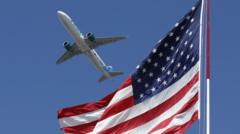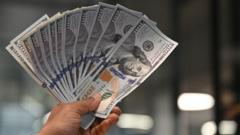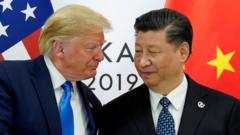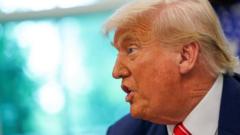The debate highlighted major party differences while Donald Trump loomed large in discussions.
**Key Insights from Canada's Final Leaders' Debate Before Election**
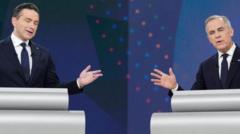
**Key Insights from Canada's Final Leaders' Debate Before Election**
Leaders clash with diverging strategies in a crucial televised showdown.
In a pivotal moment ahead of Canada's upcoming election, leaders of the four prominent federal parties engaged in their second and final debate in Toronto, with former US President Donald Trump influencing much of the discourse despite being absent. Key to the evening's events was Liberal leader Mark Carney, who is currently leading in the polls. Carney, despite facing pressure from his rivals Conservative leader Pierre Poilievre, New Democratic Party leader Jagmeet Singh, and Bloc Québécois leader Yves-François Blanchet, managed to hold his ground as they repeatedly challenged him on pressing issues.
Among the central themes was the ongoing trade war with the US, where all leaders were confronted about their strategies to negotiate with Trump over tariffs. Carney acknowledged the disparities between the US and Canadian economies, admitting that the strategy has shifted from "dollar-for-dollar" tariffs to targeted tariffs intended to minimize Canadian damage while maximizing effects on the US. The debate, however, went beyond Trump, delving into significant Canadian issues such as crime, housing, and healthcare.
Five takeaways emerged from the debate: the shadow of Trudeau's tenure continues to haunt Carney as rivals emphasize the Liberal's previous missteps; the leaders showed a notable shift in rhetoric towards negotiations with the US; focused discussions on policy specifics revealed contrasting visions for the country; smaller parties find themselves struggling for relevance amid a two-party race; and overall, a sense of decorum and civility prevailed throughout the exchanges, distinguishing this debate from its US counterparts. With the Canadian election set for later this month, the stakes are high as the public weighs its options.
Among the central themes was the ongoing trade war with the US, where all leaders were confronted about their strategies to negotiate with Trump over tariffs. Carney acknowledged the disparities between the US and Canadian economies, admitting that the strategy has shifted from "dollar-for-dollar" tariffs to targeted tariffs intended to minimize Canadian damage while maximizing effects on the US. The debate, however, went beyond Trump, delving into significant Canadian issues such as crime, housing, and healthcare.
Five takeaways emerged from the debate: the shadow of Trudeau's tenure continues to haunt Carney as rivals emphasize the Liberal's previous missteps; the leaders showed a notable shift in rhetoric towards negotiations with the US; focused discussions on policy specifics revealed contrasting visions for the country; smaller parties find themselves struggling for relevance amid a two-party race; and overall, a sense of decorum and civility prevailed throughout the exchanges, distinguishing this debate from its US counterparts. With the Canadian election set for later this month, the stakes are high as the public weighs its options.


